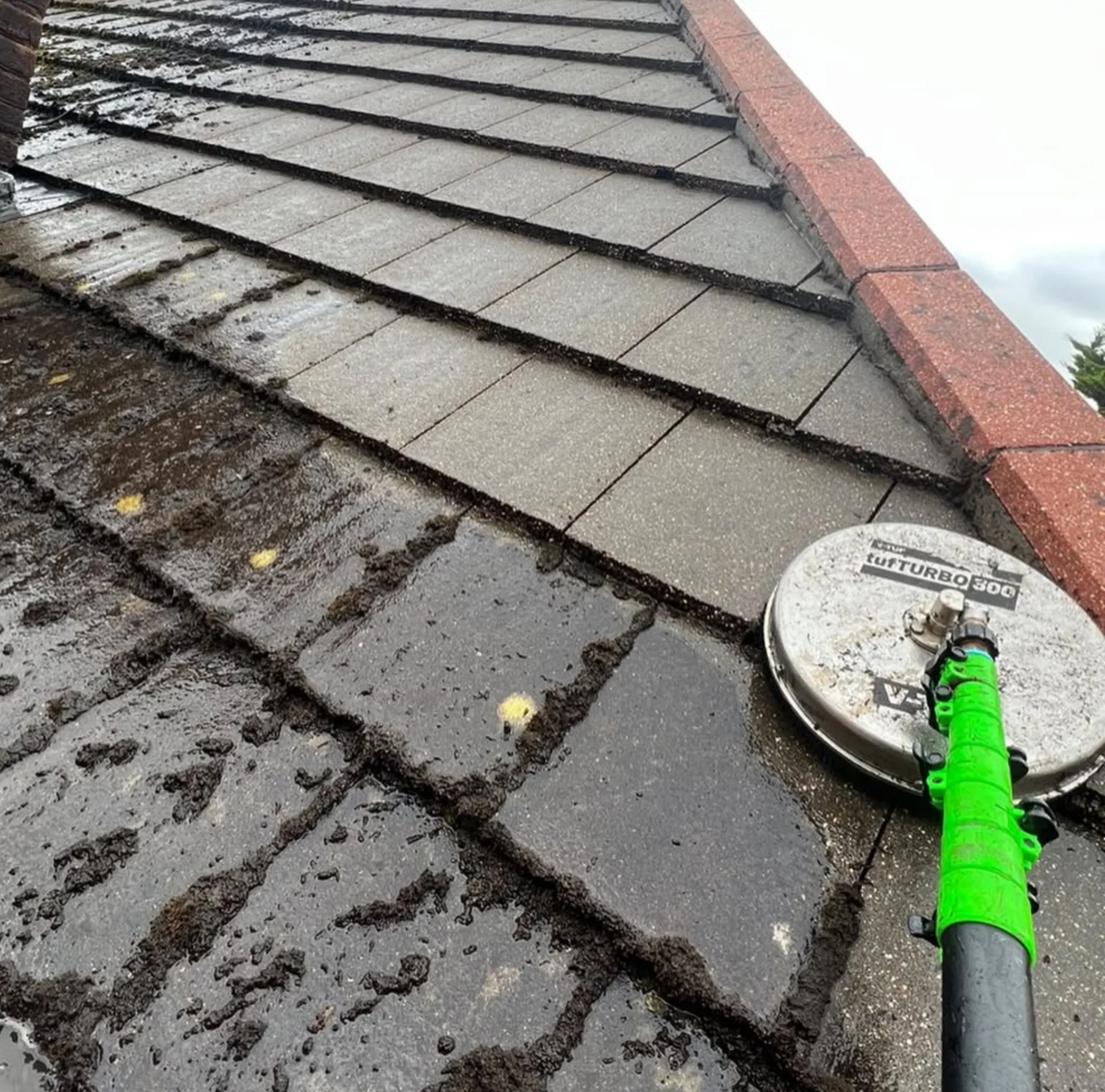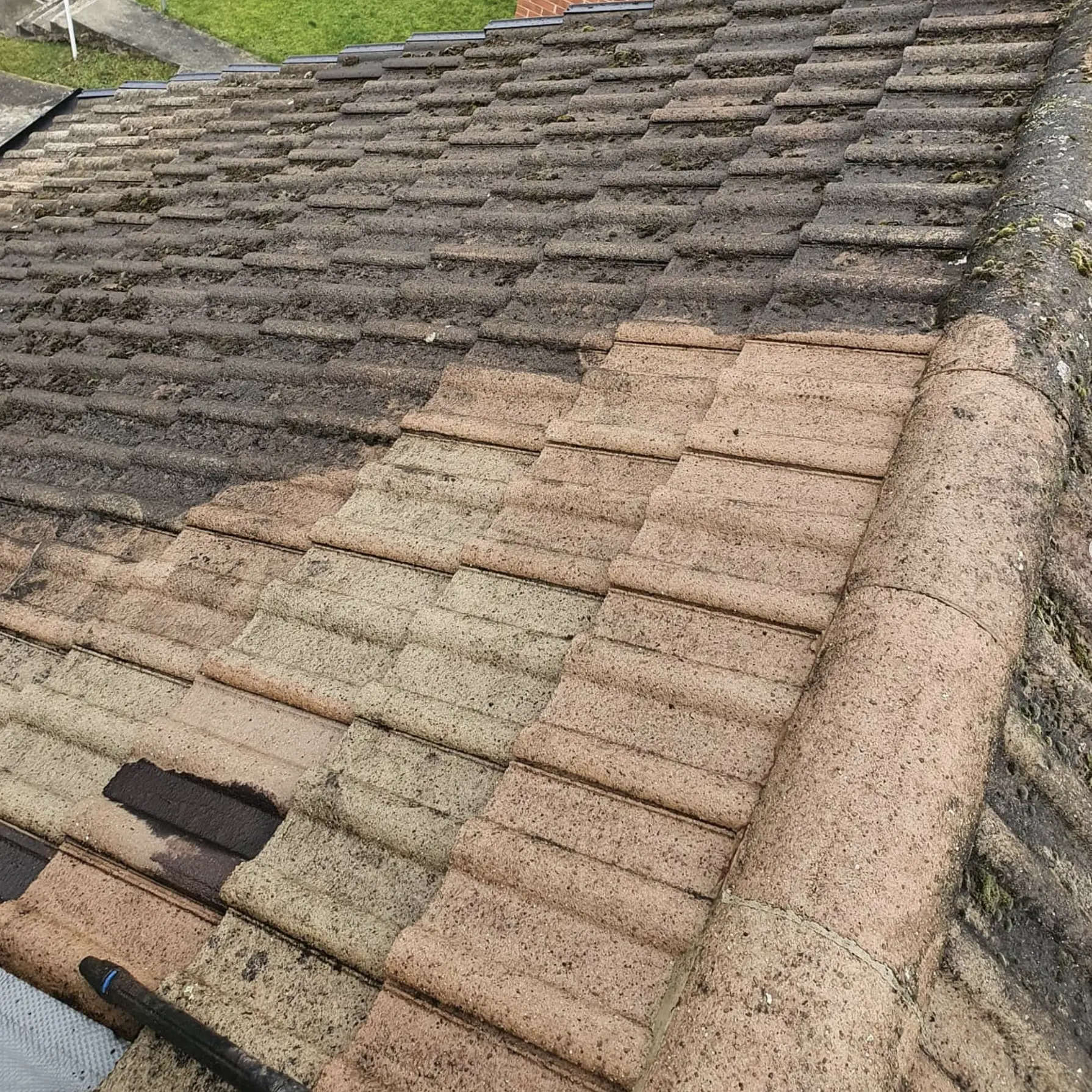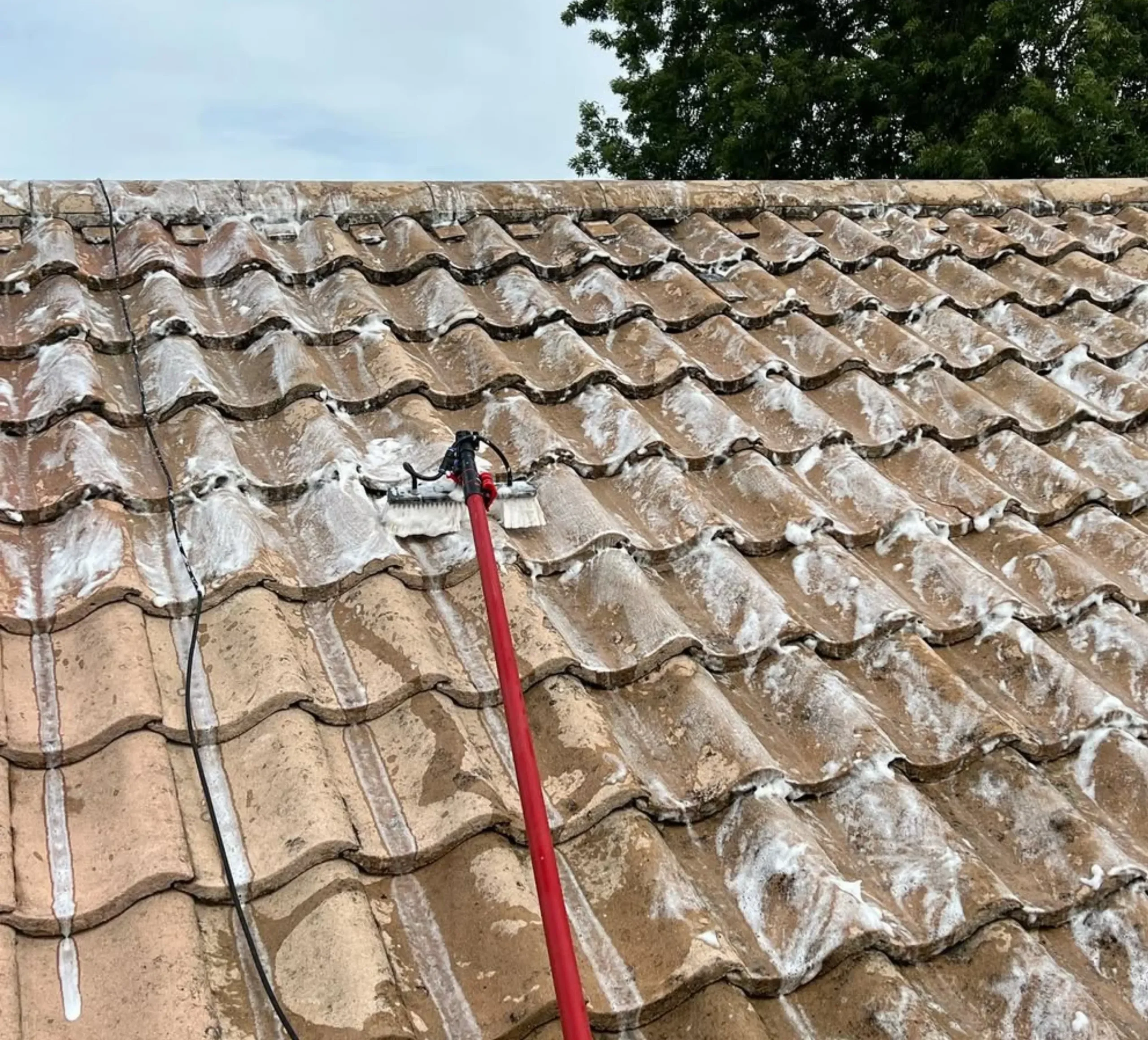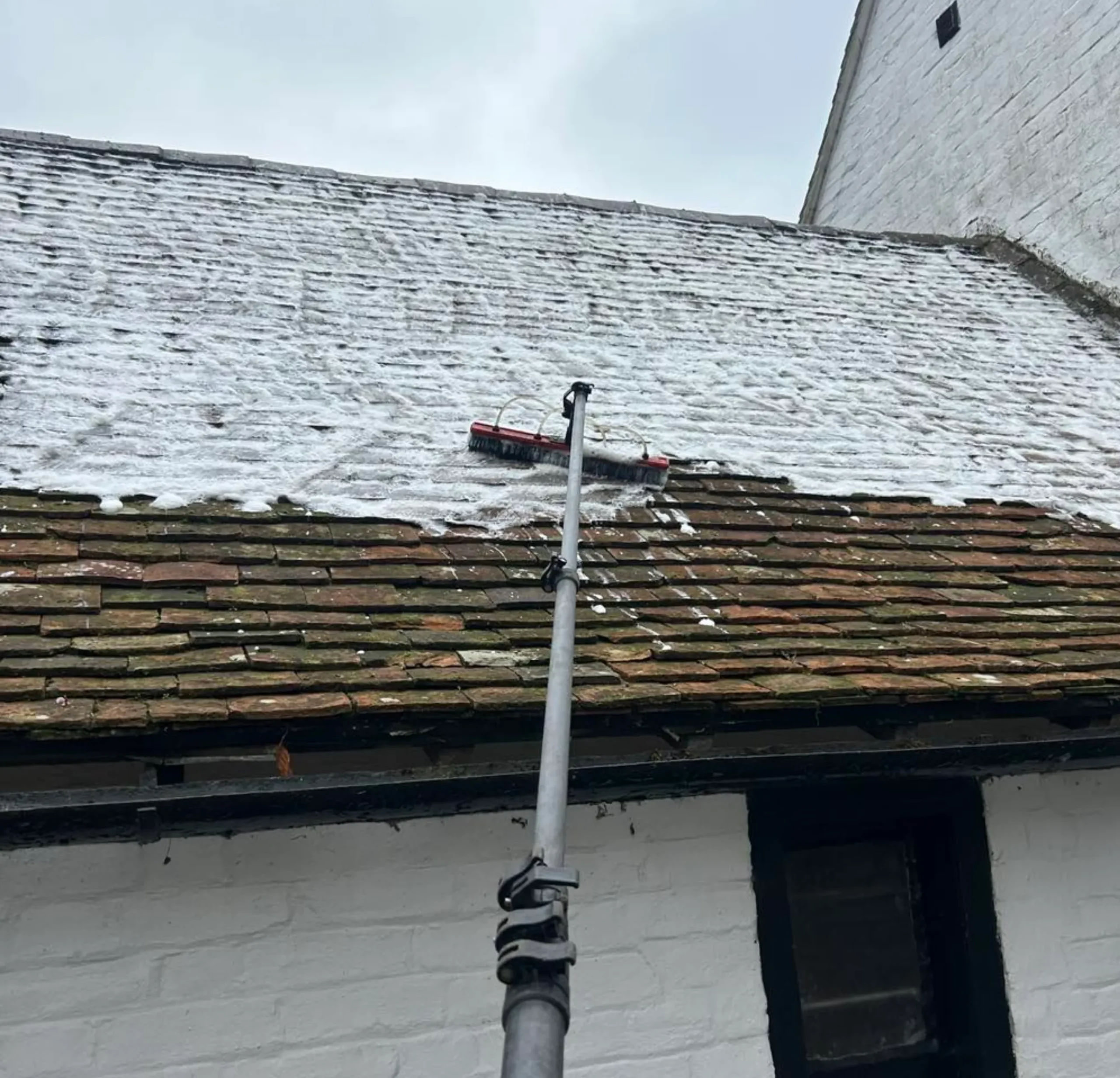
Tough on Roof Grime, Easy on Your Tiles
Gotta love a good biocide. A biocide treatment is a specially formulated chemical solution that kills off moss, mould, algae and lichen. It gets deep into the pores of concrete tiles, clay tile roofs, roof slats, and even man-made slate roofs. It works by breaking the cycle of regrowth, cutting off the source instead of just scrubbing the surface.
Not to be confused with pressure washing or power washing, this stuff is applied in low-pressure doses using soft washing gear — sometimes with projection or spray nozzles — to avoid damaging roofing materials, especially on porous roof tiles or low-pitched roofs.
And it’s not bleach — though some contain industrial sodium hypochlorite, biocide products are more refined. Brands like Benz or Wet & Forget have formulas that work in optimum conditions and are designed for long-term protection — without turning your garden into a dead zone.
Not Bleach, Not Pressure, Just Smarter
A roof biocide treatment is part cleaning, part prevention. It’s a standard practice for anyone doing professional roof cleaning, especially on Aussie homes where seasons bring everything from cyclone winds to eucalyptus sludge.
Applied properly, it:
- Kills harmful organisms on contact
- Seeps into cracks where capillary action carries moisture
- Prevents future growth of mould, moss and lichen
- No water damage from high-pressure spray
- Green growth killer over time — slow cook cleaning
It also fits into regular maintenance schedules, especially when used with soft washing and preventative measures like clearing gutters and trimming trees. If you have a roof apex, a steep roof pitch or a type of surface that’s prone to shade and sogginess, you’ll want biocide in your arsenal.

How Does It Work?
Biocides work with active agents — usually quats, bleach or hydrogen peroxide. They penetrate the cells of the range of organisms like moss and algae and kill them from the inside. Applied with application equipment like roof scrapers, hoses with projection nozzles or dedicated sprayers they target the whole entire roof, not just the obvious trouble spots.

The Cleaning Process
- Inspection — We assess the roof type, angle, access, safety (hello, roofing ladder) and identify any damage or potential damage.
- Pre-drench plant life — Crucial to protect your plant matter. We saturate nearby greenery with fresh water so it doesn’t absorb chemical runoff.
- Debris Removal — Using tools like Benz Roof Moss Scrapers or soft brooms to remove thick moss growth and leaves.
- Application — Using proper guide application rates, we spray diluted biocide evenly. We follow Product Suitability rules for your roofing materials.
- Dwell Time — Let it sit. The treatment works over days and weeks. No scrubbing, no rushing.
- Rinse Water / Clean Water — If needed we do a rinse using low-pressure water systems or just let the next rain do its thing.
We always wear protective equipment like gloves, masks and protective gear (and yes, even hair protection — seen a tradie with bleached tips from chemical burns? Not pretty).
Benefits
Here’s where biocide shines.
- Long Lasting — Biocide offers long-term protection without the frequent applications that pressure cleaning often requires.
- Gentle on Fragile Roofs — No need for a power washer or pressurised water spray that can wreck roof tiles, crack ridge caps or strip coatings.
- Eco-Friendly Practices — With eco-friendly practices, proper dilution rate and trained pros, biocide can be a safe and effective clean — especially compared to bleach or harsh chemicals.
- Less Structural Damage — By killing the root systems of lichen and moss, biocide stops capillary action from drawing moisture into the roof surface, reducing the risk of long-term damage.
- Cleaner Roof, Happier Gutters — No dirty roof means less gunk in your gutters, less overflow and less risk to your walls, garden and water systems (if you collect rainwater).


Say G’day to Regrowth
Don’t do biocide and it’s like don’t wear sunscreen — might look good now but you’ll pay for it later.
Here’s what we see:
- Moss and lichen growth
- Damage to the roof pitch and concrete tiles
- Clogged gutters full of dead plant matter and organic growth
- More expensive repairs
- Constant re-cleaning with no real protection
A common myth is that once you clean it, the job’s done. Nope. Without biocide, cleaning just scratches the surface — you’ll see that green fuzz again in months.
We’ve had clients show us Google Reviews from “budget” roof cleaners who didn’t do the chemical step — and their roofs turned green again before the bill was paid.
How Long Does It Last?
Factors That Affect Longevity:
- Moisture levels and shade
- Level of organic matter
- Roof material and type of surface
- Climate (e.g. The Wet in Darwin vs. The Dry in Adelaide)
- Whether you had a proper application in the first place
Expected Duration of Biocide Roof Treatment by Roof Type
| Roof Type | Expected Duration |
|---|---|
| Concrete roofs | 3–6 years |
| Terracotta | 2–5 years |
| Colorbond | 4–8 years |
| Clay tile roofs | 2–4 years |
| Man-made slate | 3–5 years |

Planned Preventive Maintenance
Biocide isn’t just a reactive clean-up. It’s a preventive measure. Every 2–4 years a touch-up biocide application can:
- Keep a clean roof with minimal fuss
- Stop mould growth before it starts
- Protect roof slats, ridge caps, and paintwork
- Reduce water collection risks in stormwater systems
- Keep your roof scraper in storage longer
We often recommend an alternating schedule: full soft washing every 5 years, light biocide every 2–3. It’s an economical dilution of effort — and it works a treat.
Roof Cleaning Cost Guide
Every roof cleaning company prices differently, but here’s a ballpark.
| Roof Size | Biocide Only | Biocide + Soft Wash |
|---|---|---|
| Small Home | $250–$400 | $400–$700 |
| Medium (3–4 BR) | $400–$750 | $700–$1,200 |
| Large or Complex Roof | $800+ | $1,200–$2,000+ |
Add-ons may include:
- Proper techniques for steep roofs
- Hard access with a roofing ladder or scaffold
- Multi-surface jobs with roof apex, valleys, or multi-material surfaces
Look for professional roof cleaners who understand application equipment, chemical treatments, and follow Health & Safety Executive guidelines. The wrong diluted product, or poor application under non-optimum conditions, can cause chemical burns, ruin surfaces, and harm the animals nearby.
FAQ
Can I use biocide on all roof types?
Most of them, yep. It works on concrete roofs, Colorbond, slate, terracotta — but always check Product Suitability. Some treatments aren’t ideal for painted metal or sealed tiles.
Is it safe for pets and gardens?
Not if misused. Always pre-soak garden beds and keep pets off treated areas until dry. Use fresh water to rinse overspray.
Do I still need pressure washing?
Not always. Biocide is often used alone or after a soft wash. Avoid roof pressure washing unless you’ve got tough build-up and a safe surface.
How do I know if I’m getting proper treatment?
Check that your cleaner knows about dilution rate, dry conditions, and protective steps like pre-drenching plant life. And always ask if they follow Health & Safety Executive standards.
Who to choose?
High Google Reviews, real job photos (not stock images), locals who talk about things, not just a pretty website. They carry their own water, know their roof pitch and aren’t afraid to say no to a tricky roof.
